Rishikesh Tourism Guide
About Rishikesh
Situated in the backdrop of Himalayas with pristine Ganga flowing through it, the ancient town of Rishikesh is one of the most visited tourist place and a pilgrimage hub in Northern India, where people come and attain peace. Rishikesh is commonly referred to as the ‘Yoga Capital of World’. This place is always full with visitors, who come here to learn yoga and meditation. Many youngsters come and enjoy the adventure activities like Rafting, Camping, Bungee Jumping, and many more adventurous things. Tourism in Rishikesh gets the unique mist of mythology and adventure because of the belief and faith on the holy river Ganga on the banks of which rishikesh is situated. Nowadays Rishikesh tourism is attracting tourists through river rafting activities.
Places To Visit In Rishikesh
The historic and mythological city of Rishikesh have so many things to explore and visit. There are variety of reasons for visiting rishikesh like for family vacation, for rafting, for adventure activit , for camping or for pilgrimage.
Listed below are the top places to visit in rishikesh which should be on your rishikesh tourism map.
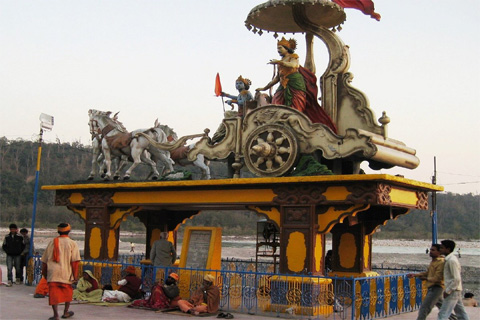
Treveni Ghat
Triveni Ghat is considered a holy spot in Rishikesh and is believed to be the confluence of three sacred rivers, the Ganges, Yamuna, and Saraswati. The ghat is known for its beautiful and serene atmosphere, and it is a popular spot for meditation, prayer, and relaxation. It is a common ritual for Hindus to take a dip in the Ganges river at Triveni Ghat and offer prayers to the river. The ghat is especially crowded during the evening aarti (prayer ceremony) held daily on the banks of the river. The aarti is a spiritual ceremony where offerings are made to the river and is a must-see event for visitors. Triveni Ghat also has a market nearby where you can buy souvenirs, clothes, and other items. The ghat is easily accessible from Rishikesh town and can be reached by foot, auto-rickshaw, or taxi. It is advised to dress modestly while visiting Triveni Ghat, and to be respectful of the local customs and rituals.
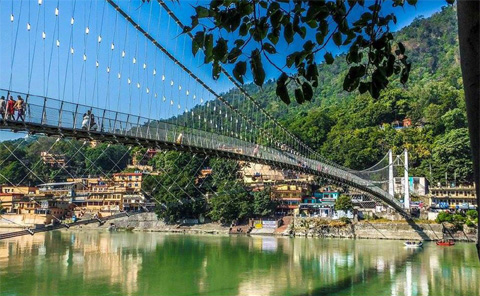
Laxman Jhula
Laxman Jhula is a 450 feet long suspension bridge that spans the Ganges river and connects the two banks of the river. The bridge is named after Lord Laxman, the brother of Lord Rama from the Hindu epic Ramayana, who is said to have crossed the river on a jute rope at the same spot where the bridge is built. The bridge is a popular spot for tourists, who come here to enjoy the scenic views of the river and the surrounding hills. Laxman Jhula is also known for its spiritual significance, and there are many ashrams and temples located in the vicinity, including the famous Parmarth Niketan Ashram. You can also find many shops and restaurants near the bridge, selling souvenirs, clothes, and food items. Visitors can also enjoy activities like bungee jumping and ziplining near the bridge. It is advisable to visit Laxman Jhula during the daytime, as the bridge can get crowded in the evenings. The bridge is easily accessible from Rishikesh town and can be reached by foot, auto-rickshaw, or taxi.

Ram Jhula
Ram Jhula is a 450 feet long suspension bridge that spans the Ganges river and connects the two banks of the river. The bridge is named after Lord Rama, the hero of the Hindu epic Ramayana, who is said to have crossed the river on a jute rope at the same spot where the bridge is built. Ram Jhula is located a few kilometers upstream from Laxman Jhula, and is less crowded than its more famous counterpart. The bridge is a popular spot for tourists, who come here to enjoy the scenic views of the river and the surrounding hills. Ram Jhula is also known for its spiritual significance, and there are many ashrams and temples located in the vicinity, including the famous Swarg Ashram. Visitors can also enjoy activities like boating and rafting near the bridge. It is advisable to visit Ram Jhula during the daytime, as the bridge can get crowded in the evenings. The bridge is easily accessible from Rishikesh town and can be reached by foot, auto-rickshaw, or taxi.
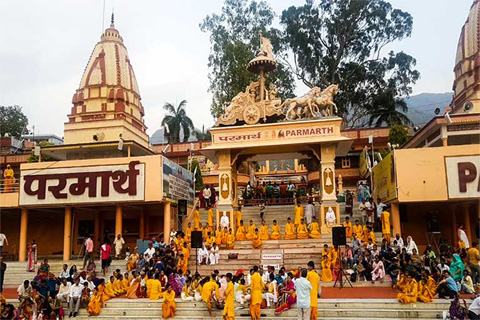
Parmarth Niketan
Parmarth Niketan is a renowned ashram located in Rishikesh, Uttarakhand, India. It is one of the largest ashrams in Rishikesh, and is a popular destination for spiritual seekers and yoga enthusiasts. Parmarth Niketan is situated on the banks of the Ganges river, in the lap of the Himalayas. It is a serene and peaceful retreat, offering visitors a chance to immerse themselves in spirituality and yoga. The ashram offers a wide range of programs and activities, including yoga and meditation classes, spiritual discourses, chanting and prayer sessions, and Ayurvedic treatments. Parmarth Niketan is also known for its social and environmental initiatives. It runs many charitable programs, including a school for underprivileged children, a hospital, and an environmental conservation project. The ashram has many beautiful gardens and temples, including the famous Ganga Aarti Ghat, where a daily aarti (prayer ceremony) is held in the evening. Visitors can also stay at the ashram, which offers comfortable accommodations and vegetarian meals. The ashram is open to visitors of all faiths and nationalities, and welcomes everyone who is interested in learning about spirituality and yoga. It is advisable to dress modestly and follow the rules and regulations of the ashram while visiting.
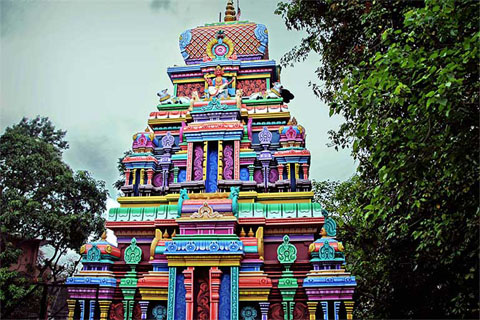
Neelkanth Mahadev
Neelkanth Mahadev Temple is a Hindu temple located in Rishikesh, Uttarakhand, India. It is dedicated to Lord Shiva, and is one of the most important temples in the region. The temple is located at a height of 1330 meters, in the midst of the beautiful Nar-Narayan mountain range. It is situated about 32 kilometers from Rishikesh, and can be reached by road or by trekking. The temple is believed to be the site where Lord Shiva drank the poison that emerged from the churning of the cosmic ocean, and thus earned the name Neelkanth (blue-throated). The temple architecture is a blend of traditional and modern styles, with intricate carvings and colorful murals adorning the walls and ceilings. The temple is surrounded by natural beauty, with the Ganges river flowing nearby and lush forests all around. It is a popular destination for trekkers and nature lovers. The temple is open to visitors from early morning till late evening. Devotees can offer prayers and perform rituals at the temple, and can also take a dip in the nearby natural hot water springs. The temple attracts a large number of visitors during the annual Shivratri festival, when thousands of devotees come to offer prayers and seek blessings. It is advisable to dress modestly and follow the rules and regulations of the temple while visiting
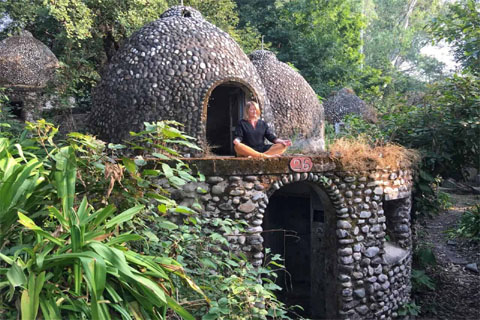
Beatles Asharam
The Beatles Ashram, also known as the Maharishi Mahesh Yogi Ashram, is a former ashram located in Rishikesh, Uttarakhand, India. It gained worldwide fame after the Beatles, one of the most famous bands in history, spent time here in 1968 to learn meditation and study Transcendental Meditation with the Maharishi Mahesh Yogi. The ashram was established in the 1960s by the Maharishi Mahesh Yogi, who was a spiritual leader and a proponent of Transcendental Meditation. The ashram was used for teaching meditation and spiritual practices to visitors from all over the world. The Beatles, along with other celebrities like Mia Farrow, Donovan, and Mike Love, visited the ashram in 1968 to learn Transcendental Meditation from the Maharishi. They spent several weeks here, during which they wrote many of their iconic songs, including "Dear Prudence", "Sexy Sadie", and "Revolution". The ashram was abandoned in the 1990s and fell into disrepair, and became a popular spot for graffiti artists and nature enthusiasts. In recent years, the ashram has been cleaned up and renovated, and is now open to visitors. It has become a popular tourist destination in Rishikesh, with many people coming to explore the abandoned buildings and artwork, and to pay tribute to the Beatles and their music. The ashram has many beautiful murals and graffiti art adorning the walls of the buildings, and there are also several meditation caves and halls where visitors can meditate and practice yoga. The Beatles Ashram is located in the Rajaji National Park and is accessible by foot, auto-rickshaw or taxi. Visitors need to pay a small entry fee to visit the ashram, and are advised to follow the rules and regulations of the park and the ashram.
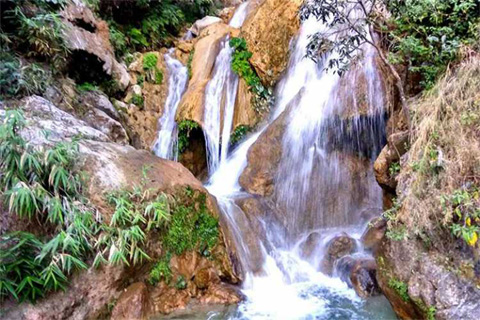
Neer Waterfall
Neer Garh Waterfall, also known as Neer Waterfall, is a beautiful waterfall located in Rishikesh, Uttarakhand, India. It is a popular destination for tourists and nature lovers, and offers a great opportunity to experience the beauty of nature in the region. The waterfall is located in the beautiful Neer Gaddu Valley, and is about 4 kilometers from the Laxman Jhula bridge in Rishikesh. It can be reached by foot, and the trek is moderate in difficulty. The waterfall is about 25 meters high, and the water falls into a natural pool at the bottom, which is great for swimming and bathing. The waterfall is surrounded by lush greenery, and the trek to the waterfall takes visitors through beautiful forests and valleys, with stunning views of the surrounding mountains. The best time to visit the waterfall is during the monsoon season (July-September), when the waterfall is at its full flow and the surrounding nature is at its greenest. There are several small food and souvenir stalls near the waterfall, where visitors can buy snacks and refreshments. Visitors are advised to wear comfortable shoes and dress appropriately for the trek, and to carry water and other essentials. The waterfall is a popular spot for adventure activities like rappelling and zip-lining, which can be organized with local tour operators.

Janki Setu
Janki Setu is a suspension bridge located in Rishikesh, Uttarakhand, India. The bridge is named after Sita, also known as Janki, the wife of Lord Rama from the Hindu epic, the Ramayana. Janki Setu is a pedestrian bridge that spans across the Ganges River in Rishikesh, and connects the two banks of the river. The bridge was constructed by the PWD (Public Works Department) of Uttarakhand in 2015, and was opened to the public in 2016. It is one of the newest and most modern bridges in Rishikesh. The bridge is about 150 meters long and 6 meters wide, and is a suspension bridge that is supported by steel cables and towers. The bridge can hold up to 8,000 people at a time. The bridge offers stunning views of the Ganges River and the surrounding mountains, and is a popular spot for photography and sightseeing. Janki Setu is located near the Parmarth Niketan ashram and the Triveni Ghat, and is easily accessible by foot or by auto-rickshaw. The bridge is particularly beautiful during the evening, when it is illuminated with colorful lights. Visitors can walk across the bridge and enjoy the beautiful views of the Ganges River and the surrounding scenery, and can also visit the nearby temples and ashrams.

Rajaji National Park
Rajaji National Park is a national park located in the state of Uttarakhand, India. It is spread over an area of 820 square kilometers and is located in the foothills of the Himalayas. The park was established in 1983 and is named after C. Rajagopalachari, a freedom fighter and the first Indian Governor-General of India. Rajaji National Park is home to a diverse range of flora and fauna, including several endangered species such as the Bengal tiger, Asiatic elephant, and leopard. The park is divided into two main regions - the eastern and western regions. The eastern region is dominated by sal forests and is home to animals such as tigers, leopards, and elephants, while the western region is characterized by a mix of vegetation and is home to species such as the sambar, chital, and barking deer. The park is also home to several species of birds, including the great hornbill, Himalayan pied kingfisher, and the crested serpent eagle. The park offers several opportunities for wildlife viewing and safaris, including jeep safaris, elephant safaris, and trekking. The best time to visit the park is from November to June, when the weather is pleasant and the chances of wildlife sightings are high. The park is located about 18 kilometers from the city of Haridwar, and can be easily reached by road. The park has several entry points and safari zones, including Chilla, Jhilmil Jheel, Motichur, and Ranipur. Visitors to the park are advised to follow the rules and regulations of the park, including not disturbing the wildlife, not littering, and not carrying any plastic items into the park.
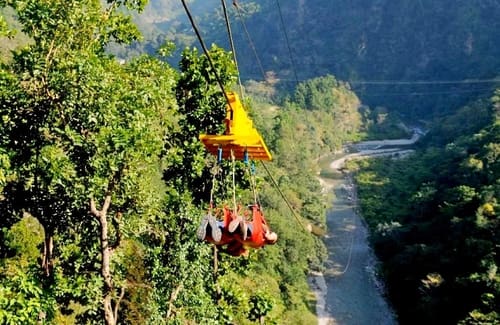
Mohanchatti Village
Mohanchatti is a small village located in Rishikesh, Uttarakhand, India. It is located on the banks of the Ganges River and is popular for adventure activities such as white water rafting, bungee jumping, and flying fox. Mohanchatti is located about 25 kilometers from Rishikesh and can be reached by road. The village is surrounded by lush green forests and the Ganges River flows through the region. Mohanchatti is a popular destination for adventure activities, and several tour operators offer white water rafting and other water sports in the area. The village is also known for its bungee jumping and flying fox experiences. The bungee jumping platform is located on a cliff overlooking the Ganges River and offers stunning views of the surrounding landscape. The flying fox experience involves being suspended from a cable and flying across the Ganges River while enjoying breathtaking views of the surroundings. Mohanchatti is also known for its natural beauty and is a popular destination for camping and trekking. The area is surrounded by lush green forests and offers several trails for nature walks and hiking. The best time to visit Mohanchatti is from September to June, when the weather is pleasant and conducive to outdoor activities. Visitors to Mohanchatti are advised to follow safety guidelines and regulations while engaging in adventure activities, and to use the services of authorized tour operators for a safe and enjoyable experience.
Brief History of Rishikesh

Rishikesh is a town in the Dehradun district of Uttarakhand, India. It is located at the foothills of the Himalayas, where the Ganges River flows down from the mountains. Rishikesh has a rich history dating back to ancient times, and is regarded as a center of spirituality and yoga.
According to Hindu mythology, Rishikesh is a place of great religious significance. It is believed that Lord Rama did penance at Rishikesh after killing Ravana, the demon king of Lanka.
Rishikesh has been a center of learning and spirituality for centuries, and is mentioned in several ancient texts including the Puranas and the Mahabharata.
In the 8th century AD, the famous Hindu philosopher and saint Adi Shankaracharya established a monastery in Rishikesh. The monastery, known as the Parmarth Niketan, is still one of the most important spiritual centers in the town.
Rishikesh was historically a part of the Kedarkhand region of Uttarakhand, and was ruled by various dynasties, including the Maurya, Kushan, and Gupta empires.
During the 20th century, Rishikesh gained prominence as a center of spiritual and yogic learning, with several renowned yogis and gurus, including Swami Sivananda and Maharishi Mahesh Yogi, establishing ashrams and centers in the town.
In the 1960s, Rishikesh gained international fame as a result of a visit by the Beatles, who came to study meditation and yoga with Maharishi Mahesh Yogi. The Beatles stayed at the now-famous Maharishi Mahesh Yogi Ashram, also known as the Beatles Ashram, and their visit put Rishikesh on the world map.
Today, Rishikesh is a thriving town that attracts visitors from around the world. It is a center of spirituality, yoga, and adventure tourism, and offers a range of activities and experiences for visitors. The town is also known for its natural beauty, with the Ganges River flowing through it and the Himalayas serving as a stunning backdrop.
Geography of Rishikesh

Rishikesh is a town located in the Dehradun district of Uttarakhand, India. It is situated in the foothills of the Himalayas and is bordered by the Shivalik range of mountains to the south and the Ganges River to the north. Here’s a brief overview of the geography of Rishikesh:
Rishikesh is located at an altitude of approximately 372 meters (1,220 feet) above sea level.
The town is situated on the banks of the Ganges River, which is considered to be a sacred river in Hinduism.
The Ganges River flows down from the Himalayas and is joined by several tributaries in the region, including the Chandrabhaga, the Bhagirathi, and the Alaknanda rivers.
Rishikesh is surrounded by forests and the Shivalik range of mountains, which form a part of the Himalayas. The mountains are covered with lush green forests and are home to a wide variety of wildlife, including tigers, leopards, elephants, and deer.
The town has a subtropical climate, with hot summers and cool winters. The monsoon season typically lasts from June to September, and the town receives a significant amount of rainfall during this time.
Rishikesh is a popular destination for adventure tourism and outdoor activities, including white water rafting, hiking, and camping. The natural beauty of the region, combined with the spiritual and cultural significance of the town, make it a popular destination for both domestic and international visitors.
